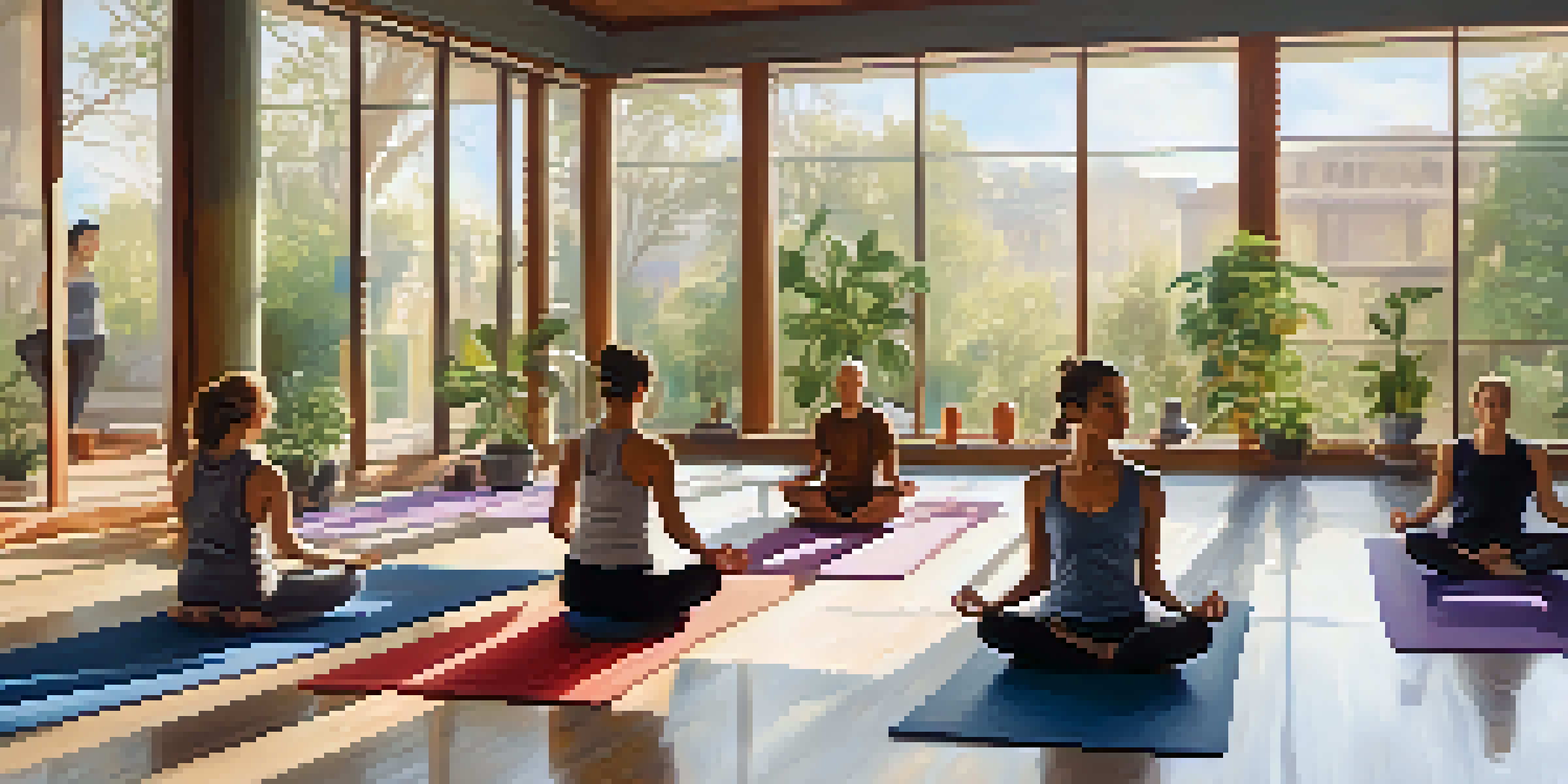Yoga, Gratitude, and the Science of Positive Psychology

Understanding the Connection Between Yoga and Gratitude
Yoga and gratitude are intertwined practices that promote overall well-being. When you engage in yoga, you not only stretch your body but also cultivate mindfulness, which is a key aspect of gratitude. This mindfulness allows you to appreciate the present moment, shifting your focus away from stress and negativity.
Yoga is the journey of the self, through the self, to the self.
Practicing gratitude during yoga can enhance the experience, making it more fulfilling. For instance, as you flow through poses, you can reflect on things you are thankful for, creating a deeper connection to your practice. This combination encourages a positive mindset, essential for mental health.
Moreover, studies suggest that individuals who practice both yoga and gratitude experience greater emotional resilience. By integrating these elements, you can foster a sense of peace and joy, ultimately improving your overall quality of life.
The Science Behind Positive Psychology
Positive psychology is a branch of psychology that focuses on what makes life worth living. It emphasizes strengths, virtues, and factors that contribute to human flourishing. This field encourages individuals to cultivate positive emotions, engage in meaningful activities, and develop supportive relationships.

Research in positive psychology consistently shows that practices like gratitude and mindfulness lead to improved well-being. By focusing on positive experiences, individuals can enhance their mood, reduce anxiety, and increase life satisfaction. This scientific backing highlights the importance of integrating these practices into daily life.
Yoga and Gratitude Boost Well-Being
Combining yoga and gratitude promotes mindfulness and enhances emotional resilience, leading to improved overall well-being.
Incorporating concepts from positive psychology into yoga can amplify its benefits. For instance, setting intentions for gratitude during your practice can transform your mindset, helping you to cultivate joy and appreciation both on and off the mat.
How Yoga Enhances Emotional Resilience
Yoga serves as a powerful tool for building emotional resilience, allowing individuals to cope better with stress and challenges. Through breathwork, mindfulness, and physical postures, yoga helps regulate emotions and calm the mind. This emotional stability is crucial in navigating life's ups and downs.
Gratitude turns what we have into enough.
For example, during a challenging pose, you may feel discomfort or frustration. However, by focusing on your breath and acknowledging these feelings, you can learn to respond with grace rather than react impulsively. This practice translates to real-life situations, enabling you to handle stress more effectively.
Furthermore, consistent yoga practice can lead to a more positive outlook on life. As you develop resilience, you begin to view challenges as opportunities for growth, fostering a mindset that embraces gratitude and positivity.
Gratitude Practices to Enhance Your Yoga Routine
Integrating gratitude into your yoga practice can be simple yet profound. One effective way is to set an intention at the beginning of your session, focusing on something or someone you appreciate. This intention can guide your practice and enhance your overall experience.
You might also consider keeping a gratitude journal alongside your yoga routine. After each session, jot down three things you are grateful for, reflecting on how they impact your life. This practice can deepen your connection to both yoga and gratitude, reinforcing a positive mindset.
Mindfulness Enhances Yoga Practice
Practicing mindfulness during yoga allows individuals to deepen their self-awareness and cultivate appreciation for the present moment.
Additionally, sharing your gratitude with others can amplify its effects. After class, take a moment to express appreciation to your instructor or fellow yogis, fostering a sense of community and support that enhances the practice for everyone involved.
The Role of Mindfulness in Yoga and Gratitude
Mindfulness is a cornerstone of both yoga and gratitude practices, helping individuals stay present and engaged. This awareness allows you to fully experience each moment, whether you are flowing through a yoga sequence or reflecting on what you are thankful for. Mindfulness promotes a deeper connection to your body and emotions.
During yoga, mindfulness encourages you to tune into your breath and sensations, creating a space for self-discovery and acceptance. By being fully present, you can appreciate the small victories and moments of peace that arise throughout your practice.
Similarly, practicing gratitude mindfully means taking the time to savor positive experiences. Instead of rushing through your day, pause and acknowledge the good, whether it's a beautiful sunset or a kind word from a friend. This heightened awareness cultivates a more positive outlook on life.
Real-Life Benefits of Combining Yoga and Gratitude
Combining yoga and gratitude can lead to tangible benefits in your daily life. Many practitioners report increased feelings of happiness, reduced stress levels, and improved relationships. These practices create a positive feedback loop, where gratitude enhances your yoga experience, and yoga fosters a grateful mindset.
For instance, someone who regularly practices yoga might find themselves more patient and compassionate, both towards themselves and others. This shift in perspective can improve interpersonal dynamics, leading to deeper connections and a more supportive community.
Simple Tips for Integration
Starting with small daily practices of yoga and gratitude can significantly enrich your life and foster a positive mindset.
Additionally, the physical benefits of yoga, such as increased flexibility and strength, are complemented by the emotional benefits of gratitude. Together, they create a holistic approach to well-being that nurtures both body and mind.
Getting Started: Tips for Your Yoga and Gratitude Journey
If you're interested in incorporating yoga and gratitude into your life, start small. Set aside a few minutes each day for a simple yoga practice, focusing on your breath and body. As you become comfortable, you can gradually explore different styles and deepen your practice.
Alongside your yoga, establish a daily gratitude routine. This could be as simple as jotting down three things you’re grateful for each evening or sharing your gratitude with a partner. Consistency is key, so find a method that resonates with you and stick with it.

Lastly, consider joining a community or class that emphasizes both yoga and gratitude. Surrounding yourself with like-minded individuals can provide motivation and support, making your journey more enjoyable and fulfilling.